Judaism and Christianity
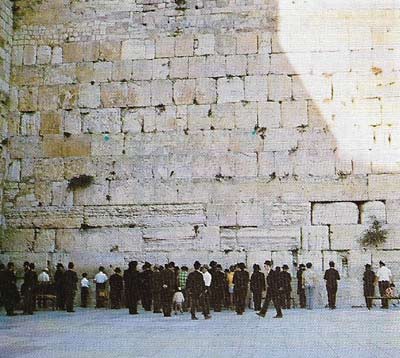
Figure 1. The Western Wall (also called the Wailing Wall) in the Old City of Jerusalem is a place of prayer and pilgrimage that is sacred to the Jewish people. According to rabbinical belief the divine presence never departs from it. It is all that remains of the 2nd-century BC Second Temple destroyed by the Romans in AD 70.

Figure 2. The original golden menorah, or ritual candelabrum, was shaped by Moses ac-cording to the pattern of the almond, Israel's most sacred tree. It is used during the eight-day festival of Chanukkah and its branches symbolize the seven days of creation. The middle cup signifies the Sabbath.
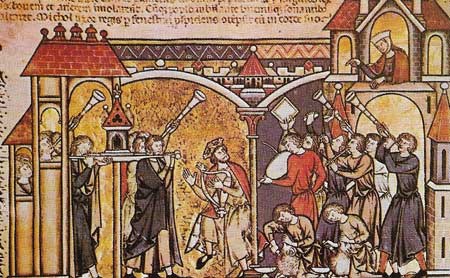
Figure 3. Obedience to the Lord – the keeping of the Covenant – is fundamental to Judaism. The Ark of the Covenant, a gold-plated chest that housed the two tablets given by God to Moses, was supposedly constructed after Moses saw a fiery replica coming down from heaven. Originally kept at Shiloh and brought out during battles (as depicted here in a 13th-century French manuscript), it was put by Solomon in the Holy of Holies in the Tabernacle at Jerusalem. After that it was seen only by the high priest on Yom Kippur, the Day of Atonement. Its eventual fate is completely unknown.
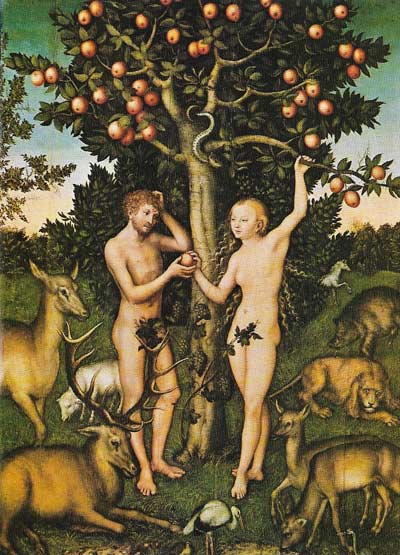
Figure 4. The story of Adam and Eve, splendidly portrayed by the German painter Lucas Cranach (1472–1553), is an allegory of man's fall and his anguished sense of separation from cosmic unity. What was the sin of Adam and Eve in eating fruit of the Tree of the Knowledge of Good and Evil? The Trappist monk, Thomas Merton (1915–1968) saw it as an act whereby man tried to appropriate for himself that which God would give out of His own love. The "original sin" is thus an act of pride stemming from lack of trust in the goodness of God.
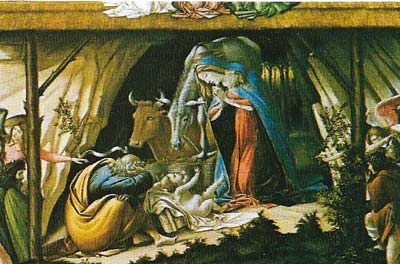
Figure 5. God's divine love, expressed in Botticeli's "Nativity" (1500), was translated by St Paul into ethics in the spiritual life. The result was agape or caritas – the active concern for the wellbeing of others.
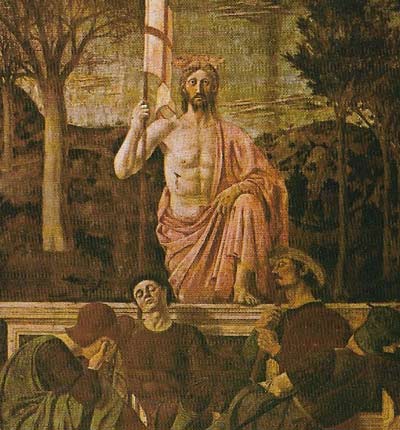
Figure 6. This resurrected figure of Christ by Piero della Francesca (1420–1492) conveys the promise of rebirth after death. The suffering of Jesus on the Cross is an indictment of man's inherent drive to crucify or murder the Truth that can save. But the resurrection demonstrates God's forgiveness and the rebirth possible for people who can face their own corruption and accept the help of God.
The fundamental message of Judaism is expressed by the prayer: "Hear, O Israel, the Lord our God, the Lord is One." This prayer is named by its first word – Shema ("listen", "hear", "understand", "obey"). It calls men to hear the truth that has been revealed, to take it to heart and to live by it in order to realize the unity of God in a relationship that demands of a man that he unify his own being.
The Jewish covenant and what it means
Judaism is the religion of a covenant between Yahweh (God) and the descendants of Abraham who was prepared, when tested, to sacrifice his own son to Him. From the Covenant radiates the mystery of an agreement between man and God. It is in the actions that make up the history of the chosen people that the teachings of the Jewish faith are set forth. The Lord appears in all the transcendence of His absolute power and at the same time in the immediacy of personal concern for His people. He brings Israel out of slavery in Egypt and into the promised land. For the Jew, the "choosing" of his people parallels the mystery of man's being created in God's image. As Israel is called to realize its covenant, so man is called to fulfill the promise of his being. The Jewish philosopher Martin Buber (1878–1965) writes: "Man must liberate himself because man is a microcosm and there is in him Pharaoh and Egypt; he is enslaving himself."
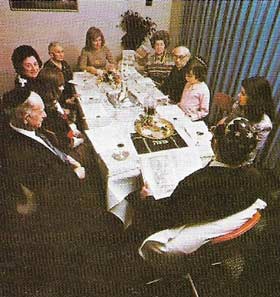 |
| During the festival of Passover, Pesach, Jews commemorate their deliverance from Egypt, the prelude to the forging of their eternal covenant with God. The family gather for the Seder night service to retell the events from the Haggadah and answer children's ritual questions. Dishes symbolizing the hardships of slavery are prepared and only unleavened bread, marza, is eaten. Each person tries to feel as if he personally were saved by God and looks forward to a future redemption. |
In Jewish mysticism, the symbolism of exile and return finds yet another level of interpretation, this time on a cosmic scale. Medieval Kabbalists, interpreters of the Torah – the law God gave to Moses – and its rabbinical commentaries, saw in the failure and exile of cosmic man – "Adam Kadmon" – the scattering of the sparks of the divine Shekhinah, the presence of God in the whole of creation. The redemption of man is thus intimately bound up with the redemption of creation.
 |
| Moses, the great law-giver of the Jews, is depicted here by the French artist Gustave Dore (1833–1873) with a gravity that is reflected in Mosaic law itself and which represents the absoluteness of God's word to man. According to Hebrew tradition, Moses led his people out of bondage in Egypt (probably between the 14th and 12th centuries BC) and it was to hits that Yahweh revealed the Ten Commandments in the Sinai wilderness. These laws, which the Jewish people carried with them to the promised land are the epitome of the demand for righteous action that characterizes the entire tradition of Judaism. |
This conception of man being responsible for the whole of creation had its greatest modern influence on Judaism in the communities of Hasidim, "the pious", which arose in Poland in the 18th century. In the Hasidic way of life, there is no separation between sacred and profane. Everything that exists contains within it a divine spark waiting to be liberated. According to this teaching, there is in man a divine energy through which divine sparks that are present everywhere can be attracted and set free. All depends on intention, the condition of a man turned to God with his whole being. For the Hasid, everything he meets in the course of his day is holy and according to the Torah everything can be brought back to union with God.
Christianity and divine love
The whole of Christian religion is centered on the mystery of divine love. Man's task is to respond to that love. From the very source of Christianity come the words of Jesus addressed to the Jews in their own terms: "Thou shalt love the Lord thy God with all thy heart, and with all thy soul and with all thy mind. This is the first and great commandment. And the second is like unto it, Thou shalt love thy neighbor as thyself. On these two commandments hang all the law and the prophets" (Matt. xxii: 37–40).
Later the Christian faith came to include people who lacked the common basis of Judaism. In response to their need and in the face of the claims of then current systems of thought, Christianity began to take shape as an independent religion.
In its unique perspective, everything that exists was brought into being as an expression of divine love and is moved by that love to "be what it is", to fulfill its own nature as the plant reveals the secret contained in the seed. But in the order of creation, it is man, made in the image of God, who stands out as the element of uncertainty, the great risk freely undertaken by God so that His love might be freely returned.
In Adam's fall (Figure 4), the limited and separate existence of the natural world apart from its Creator asserted itself. Yet this failure is sometimes called "the happy fault" because it led on to the greatest act of divine love. The father's sacrifice of his son was fulfilled in a new covenant. The Son of God became man (Figuree 5). In the person of Christ, the way was reopened. The Incarnation mysteriously united in Christ the two natures – human and divine – and the passion and death of Jesus demonstrated this unification in the perfect submission of human will to divine will. Finally the resurrection of Christ (Figure 6) promises the fruit of sacrifice, the "new man" in whom limited nature is transformed by divine life. "Unless the grain of wheat falling into the ground dies, itself alone remains; but if it dies it brings forth much fruit" (John xii. 24). And similarly: "He that findeth his life shall lose it; and he that loseth his life for my sake shall find it" (Matt. x: 39).
The search for God through contemplation
A deep and serious response to this call can be found in the Christian contemplative tradition. To the modern person the idea of contemplation may call forth associations of daydreaming or sentimental ramblings. This is far from the contemplative's understanding of his work and its demand for a quality of awareness and impassioned searching that can bring him to the core of his being, there to discover his true need for God. Confused and alienated as a result of Adam's fall, man must struggle to discover within himself the central impulse of love, "Be what he is".
